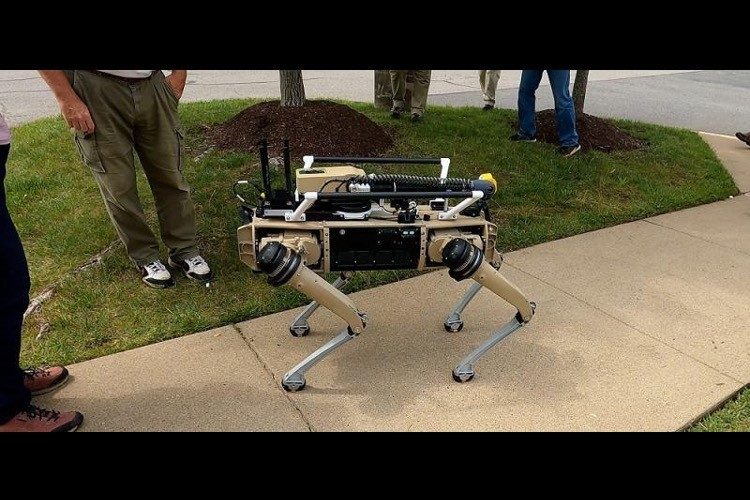
As the American southern border became wide open to anyone who wants to cross it, the Biden administration seems to be relying on new technology to address the issue. The U.S. Department of Homeland Security (DHS) said it is testing robot dogs — formally called “Automated Ground Surveillance Vehicles” (AGSV) — for use in monitoring the trespassing.
According to the DHS’s Tuesday press release, “The goal of the program is to leverage technology to force-multiply the CBP [U.S. Customs and Border Protection] presence, as well as reduce human exposure to life-threatening hazards.”
The agency describes that the Southwestern region “is vast and monitoring it is critical to our nation’s security.” It continues,
The Science and Technology Directorate (S&T) is offering CBP a helping hand (or “paw”) with new technology that can assist with enhancing the capabilities of CBP personnel, while simultaneously increasing their safety downrange….
For instance, S&T is currently supplementing CBP’s bipedal human personnel with quadruped mechanical reinforcements to help the agency better allocate resources. In this case, Man’s best friend comes with a very futuristic twist.
People should not be “mystified” by the new technology, the agency remarked. “Technology such as semi-autonomous drones (air, ground, and even water) are used effectively as force multipliers elsewhere — and robot dogs are no different,” said S&T program manager Brenda Long.
The DHS’s release, however, seemed to be designed to portray robots in the most likable way. For example, it referred to the 100-pound machines as patrol officers’ “best friend.” The agency also used veterinary terms to describe robots’ parts, calling treads “paws.” At one point, the machines were called “pooches.”
The agency noted that the “dogs” have been successfully tested in Lorton, Virginia, during the “initial payload integration” phase. The so-called payloads refer to video and other sensor packages that, being mounted onto the robots, can transmit real-time video, audio, and other data back to the human operating or monitoring the AGSV.
Ghost Robotics boasted that it was able to integrate various types of cameras (360-degree, thermal, night vision, zoom, etc.) and sensors (chemical, biological, radiological, nuclear, etc.) onto the robots, per the release.
As the preliminary results were highly satisfactory, the robots were moved to El Paso, Texas, where their capabilities were assessed in realistic scenarios. For example, the scientists evaluated robots’ ability to maneuver in harsh environments and tight spaces, such as under train cars at rail yards.
For example, in one of the “exercises,” the robots were taken to a training facility that was built to replicate a residential building. Per the DHS, “There, the robot dogs would encounter a scenario that simulated being met by potentially hostile individuals. Set to the operator driven mode and using the wireless connection, the operator would maneuver the AGSV to enter the structure, move through hallways, and peer around corners, as well as navigate stairs.”
The robots are also capable of going into an autonomous mode when they patrol the perimeters with pre-set GPS waypoints. The designers also said that they dedicated a lot of effort to extending the robots’ battery life to ensure they could execute lengthy missions and then return to base safely.
Ghost Robotics, a U.S. military contractor, made national tech news headlines back in October 2021 when it displayed a robot dog equipped with a rifle at the Association of the U.S. Army’s 2021 annual conference in Washington, D.C. A custom gun was made by a small-arms manufacturer Sword International.
The Verge reported at the time, “It seems the gun itself (dubbed the SPUR or “special purpose unmanned rifle”) is designed to be fitted onto a variety of robotic platforms. It has a 30x optical zoom, thermal camera for targeting in the dark, and an effective range of 1,200 meters.”
The outlet added that while it was unclear whether the armed “robot dogs” were available for deployment, it was likely that they will be in the near future. The outlet cited Sword’s marketing webpage, which claimed that “The SWORD Defense Systems SPUR is the future of unmanned weapon systems, and that future is now.”
In an interview with TechCrunch last October, Ghost Robotics’ CEO Jiren Parikh said that the company’s robots “are not using any type of autonomy or AI for targeting weapon systems.” He could not say if Sword International had any such projects. Parikh also said that the company did not know what their government clients plan to mount on the robots.
The DHS, for its part, did not mention if the robots that are currently tested would be equipped with any weapons.
There’s no specific timeframe for deployment noted in the DHS’s post, either.
The first unit in the Department of Defense to make quadrupedal robots a part of its patrolling missions was the 325th Security Forces Squadron at Tyndall Air Force Base, located in Florida, back in November 2020.
The U.S. Border Patrol reported more than 1.6 million encounters with illegal aliens along the U.S.-Mexico border in the 2021 fiscal year, “more than quadruple the number of the prior fiscal year and the highest annual total on record,” according to Pew Research.



